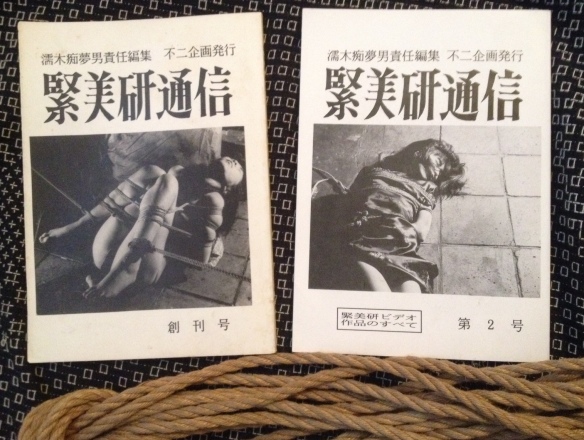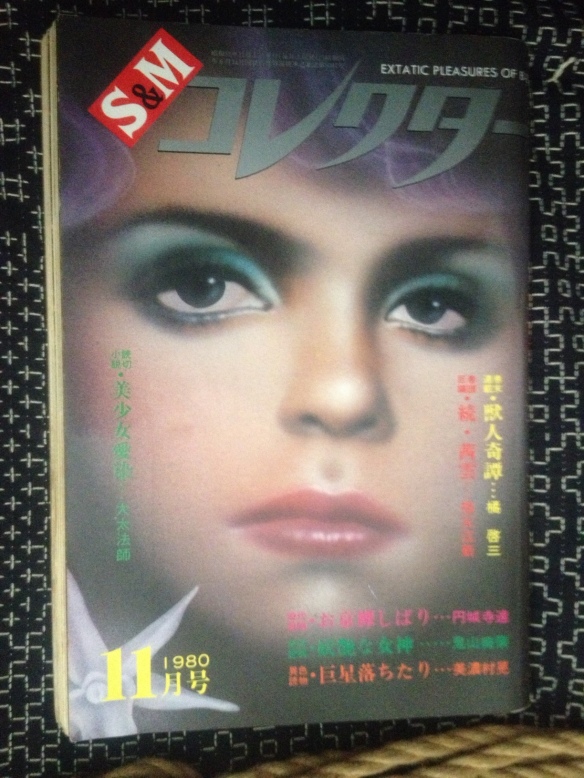
I am happy to present to you a translation of a long text that Minomura Kou wrote about his reminiscences of Itoh Seiu and published in the magazine SM Collector in November 1980. I will not spoil it with further comments of my own – but I will ask again anyone finding this blog to be of interest to consider making a small donation. Details here: https://kinbakubooks.wordpress.com/2018/08/09/call-for-donations-5/
Translated by Shiba, commissioned and edited by Bergborg / KinbakuBooks
****
A great man has fallen
by Minomura Kou
My primary profession was as a painter. I was an apprentice for a Japanese painter called Kobayashi Baisen [1889–1969] in Kyoto. I was there until I joined the navy. I became strange [”oka-shi”] after coming back from the war.
I started to submit paintings to Kitan Club and somehow along the way I became an editor. Around that time, I also started writing stories and fiddling with the camera. Before long, I became a nawashi. My pen name for my paintings was ‘Kita Reiko’, which is my wife’s maiden name. I just used it as it is. One might wonder why I would use my wife’s name as a pen name, but there are many reasons for it and I can’t possibly write about all of it without this becoming too long. Simply put, Minoru-san [the editor] of Kitan Club, thought it would be best.
When I came back from the navy, I first became an editor for a local newspaper in Kyoto. From there I became a reporter and it was my first time in this profession. My first experience with printing type was before I was born. My parents were in the printing business and doing work for the publishing business. So, it’s safe to say I was in the right place.
Also, I’ve written about this before as a chance, but my grandfather was an eager collector of SM (though there wasn’t a word for it back in the old times… The term seme that Seiu-sensei used, was only used long after my grandfather’s time), and it thrilled me to the point to leading me down this path.
If I had been a dry-goods-dealer’s son… or maybe a greengrocer’s son, I would probably have remained only a reader of these kinds of things. However, being born into a family in the printing business, I grew up playing with printing types and watching the process of publishing various things. On top of which, I also had the beautiful seme-e [artistic images of torment] my grandfather left behind, and I thought I also wanted to paint pictures like that. So, I went to art school and became an apprentice for a Japanese painter. Amidst all of this, the war came and I had to take a break from this to join the navy. I barely stayed alive. In the end, it led me to the ropes and here I am.
I first heard about Itoh Seiu-sensei when I was 12–13 years old. He had painted some of the seme-e included in the book “Hentai fuuzoku shiryou” [1929] that was in my grandfather’s book collection, and there was also an introduction to his art.
Much later, in 1954, I met him in person in Tokyo. Mr. Saito Yaigo and Mr. Dan Oniroku have written a lot about Itoh Seiu-sensei, so there is no need for me to say much more, but he was the starting point for the birth of SM magazines. He is also a kind of master [shi] to me. My only regret is, however, that I never had the chance to be called his apprentice [deshi].
When I was working with Kitan Club, I received a letter from him, and in it said, “I’ll take you as a pupil [門下, monka] if you want to”. That was however only after I had written to him many times asking for his permission. However, the one accepted as a disciple was Kita Reiko, and the letter was also addressed to Kita Reiko. It seems he thought I was a woman. At the time, I was in Sakai in Osaka and working as an editor for Kitan Club and drawing under the pen name Kita Reiko. It was there that Sensei saw my paintings and that was the start of it.
It all started with me replying under my pen name to show my gratitude, but with time the exchange of letters grew. The contents of sensei’s letters were mostly about paintings; They were skilfully written on Japanese paper, stating things such as “that lamp is better drawn in this shape”, and “when a woman’s hair starts to become disarranged, it’s like this” etc, and he would also clarify for me the intentions of his drawings. Just like a kind master teaching his female apprentice.
As this progressed, it was hard for me to tell him that I was actually a man, so I never did.
Then, one day I received a letter where he wrote “…A play called Christ in Bronze will be played in Osaka and [the actress] Hanayanagi Okiku will be tied up in it, so please go see it. Also, I have written to [the kabuki actor] Ichiawa Kojiro about you, so take this other letter I’ve included with you and meet with him…”, etc.
I was troubled. I thought: ‘This has become quite a mess’. This other letter where he had written about me to Kojiro, was in an envelope, but it was not sealed, so I read it.
It said: “the woman bringing this letter is my disciple Kita Reiko. She is a female painter…”, etc.
He wrote that Reiko is researching seme-e and that he thought this play would be a great opportunity to learn. It was a very detailed introduction to Reiko.
Ichikawa Kojirou has now [1980] already passed away [1957], but he was famous for his acting. In this play, he was playing a persecuted Christian, a very important character.
I knew nothing of kabuki or of theatre at all, but I had heard he was somebody referred to as danna [Master] in the dressing room. He was actually one of the best, but I only found that out later.
Nevertheless, I was troubled.
The letter said, “the woman bringing this letter….”, but I am a man so nothing could be done. Even if I had my wife go in my place, he would probably know something was wrong as soon as they started talking.
What to do, what to do…? I regretted replying to sensei with my pen name from the start. However, I also couldn’t not go see the play “Bronze Christ”. Receiving countless of kind letters, slowly dragging myself deeper into the lie I had started with, now it had come to this. I was at my wit’s end when Minoru-san, the editor of Kitan Club, said: “I don’t really think there’s a problem. Go meet that Ichikawa Koujiro and tell him the truth. There are a lot of reasons for this, so don’t think about it too much!”
To tell the truth, the publishing company wanted the readers to believe that Kita Reiko was a woman and slowly it had become like this. It wasn’t like I wanted to deceive sensei at all. So, with that conclusion I decided to write a reply to sensei. I thought that it would be the end of my apprenticeship, so I wrote by the name Reiko. But the letter was returned to sender. Only three days later, I received a new letter from sensei. The correspondence became heavy. I decided to meet Mr. Ichikawa Koujiro and explain the circumstances and send my apologies to sensei through him. To make it smoother, I thought I would attend the closing party for “Bronze Christ”. Although I was scared, I thought it was a good opportunity to apologise and decided to go. Even so, as the day came, I’m sure you readers can imagine I was worried.
*
It was the last performance for ”Bronze Christ”. The people in the dressing room were busy. I remember feeling it wasn’t a place for someone like me.
I finally met Mr. Koujiro. He scratched his head as he read the letter from sensei. He looked puzzled and said: “Are you the person in question?” It was the last performance of the play and he was still in his stage clothes. From there, I told him everything from the beginning to end and ended with saying to him: “… so this is how it is. Can you please tell him this when you get back to Tokyo?”
Mr. Koujiro said: “Mr. Seiu told me about you. He said that you are a young and beautiful woman, so I was wondering when she’d come by. It has been on my mind. Today is the last performance, so I had almost lost hope of her coming”, and smiled bitterly.
“Even so, you’re a cruel person. Seiu-sensei will surely telephone me once I get back to Tokyo… but what am I to say?”, he said and pondered.
I was also troubled by this. What should I do?
Koujiro said: “Seiu-sensei has talked about coming to see you in Osaka, so what will you do? Until now, you’ve said you’re a woman, and you should not make an old man disappointed… No, I will say I met a beautiful woman…”
That’s what he said. That he would be lying to Seiu-sensei until the end. Mr. Koujiro wasn’t wrong to think like this; it was an act of kindness towards an old man. He asked me what he should tell Seiu-sensei about his meeting with Kita Reiko. Looking at the letters I received after this, it seems Mr. Koujiro really told him Reiko was a very beautiful woman.
“Bronze Christ” was well played, and highly praised in the newspapers. It might sound uneducated coming from a lowly person like myself, but I remember the scene with Hanayanagi Okiku being crucified as very realistic. I was taken in by her expression of anguish and her movements.
On that day, it was the last performance. The stage curtains went down and I was a bit absentminded. I could see Mr. Koujiro, waving to me, saying: “Here, come here, this way”. Going under the curtains on to the stage, there was a table with a white cloth laid out and on it was sake and beer and some snacks.
Before long, an important-looking person came and greeted everybody and proposed a toast. In hindsight, I think this is probably some kind of custom for the last day of performance.
I knew nothing of this theatrical world, and didn’t think anything but just raised my sake glass. Bando Mitsugoro, a famous kabuki actor (he later passed away from fugu poisoning in Kyoto) and Ms. Hanayanagi Okiku were standing right next to me! We were being jammed together and our shoulders bumped together so I unintentionally spilt the glass of sake in my hand. I hadn’t noticed that I was in the best seat of honour. I’ve been thinking of this a lot afterwards, but I was young back then. I didn’t think of the position my lowly self was in, so the others must have thought: “Who is he? What a helpless person, he doesn’t even have proper manners!”
And so, I went to Tokyo in 1954 and worked for the company Amatoria-sha and became an editor for the magazine Amatoria. This later lead to meeting Seiu-sensei, but it was my impression that he did not suspect that I was indeed Kita Reiko. After a sequence of events, he even seemed to think I was her husband.
He said things like: ”Minomura-kun, is Reiko doing well?”
Not knowing what to answer I said: ”Y-yes! She is doing very well!”
For this reason, it seems that sensei really thought that Reiko was his disciple, and that Minomura Kou only was an editor. However, Kita Reiko is indeed a part of me, so in this sense I am truly sensei’s disciple.
In this weird way, the incorrect assumption continued into sensei’s grave. I will talk more about this later, but I have a feeling sensei surely knew the truth, but then decided to pretend to not know of it. In the early days, there was this letter from sensei addressed to Reiko that sounded like a love letter, depending how you read it (of course, at this point, sensei must have thought Reiko to be a woman). Weirdly, sensei kept perceiving his dreamlike romance, and to this day I think it’s a bit strange. It would be sad and unfortunate if the illusion of the sweet Reiko would be destroyed by my appearance. Then again, the great Seiu-sensei was probably not somebody that would fuss over something like that. He was by nature a person with a very kind heart, and he might have forgiven me for the fact that the illusion is only an illusion.
I know the late Mr. Takahashi Tetsu heard of these love letters of Seiu-sensei from somebody, and searched for and tried to get a hold of them, but that came to nothing. It seems Mr. Takahashi Tetsu didn’t have the best impression of me, and I know the reason for this, so we weren’t close at all. Mr. Tetsu’s reason for disliking me had to do with Mr. Numa Shoso. Shortly before coming to Tokyo, there was an issue of Kitan Club where Mr. Takahashi Tetsu was criticised by Mr. Numa, and this strangely bothered Mr. Takahashi. In this instance, Mr. Takahashi knew I was an editor for Kitan Club and that was how our problematic relationship started. He must have thought I had egged on Mr. Numa to criticise him, so we weren’t really on good terms.
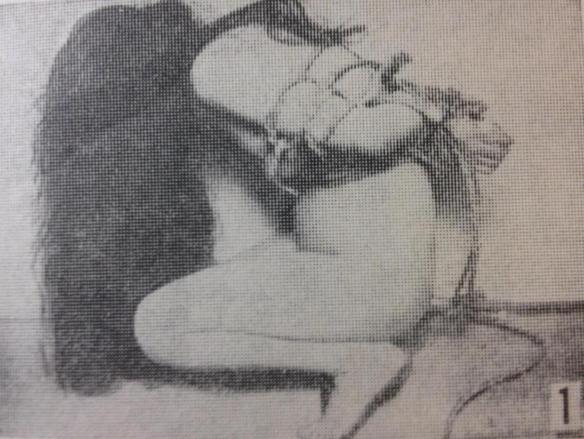 Picture 1: The first time I saw fully nude shibari
Picture 1: The first time I saw fully nude shibari
I just investigated about this and found out that Mr. Numa’s ‘Takahashi criticism’ was published in the 1954 April issue of Kitan Club. I’ve found a lot of interesting articles looking back at Kitan Club like this, so I’ll talk about some of them. For example, Itoh Seiu-sensei’s essay in the 1953 January issue of Kitan Club. The title is ”My Emotional Landscape When Drawing Women in Torment”. This is the text:
I was only 17 years old when I started wanting to draw women in torment. To be blunt, it was because of my youth and horniness. I was a sculptor’s apprentice then, made minimum wage, and had no experience tormenting women. I used to put thin paper over newspaper images of women to copy them, and then draw rope on top of the images. I was once caught by another apprentice doing such thing, and remember my face turning bright red. With time, I began making a living out of painting, and I can still remember the joy I felt when I sketched my young wife (who was not extraordinarily pretty in any way), tied up with a kimono sash.
For a while, I thought that the best way to study women being tormented was to go to the theatre. I began going in and out of the dressing rooms of various theatre performances, where I took photos of male actors who play women’s parts, and sketched them in rope. Those who had no understanding of what I did labelled me “pervert”, but I did not care. I enjoyed my “investigations”, and those investigations of “women in torment” have now been going on for more than forty years. I had no idea where I would end up, nor did I have a clear goal. I simply loved “women being tormented”, and was obsessed with my drawings. Just like a person who loves fishing goes out to fish, I decided to go deeper and deeper into my interests. Since there are no other reasons behind my work, I like to think my emotional landscape when drawing women in torment is no dofferent than that of Utamaro when he was painting shunga. There are no scenes of women being tormented in shunga, but I believe that the aesthetics at the core – that of making something ugly into something beautiful – is something that my work shares with shunga.
The fact that Kitan Club, a magazine specializing in the reverse (?) was created in the Kansai area and not Tokyo, proves the intelligence and business-orientated mindset of those originating from the Kansai area.
The publisher has used an amateur female painter to spark an interest in people. The works of Kita Reiko, a woman, are very good, and have a quite feminine, soft touch. She has been like a kite pulling everybody along the way. But it almost seems, though, like publishers and fans of fetish culture applaude Kita’s work simply because of the fact that she is a woman. Not differentiating her work from her gender is a messy way to kill her career. Businessmen today, even in the publishing business, don’t take care to let people go through training. They care more about the already established people and that is a bad habit. It would take me another 10 years to train and refine the woman Kita Reiko.
As someone who did not complete elementary education, my own drawings are not that different from those done by amateurs. Those who can only create compositions from still life are unable to sketch moving people. You are only a “professional” if you both have full knowledge of the human body and anatomy, and are able to come up with compositions of scenes of torment. Beyond that is up to your talent. To draw women being tormented it takes, like Lao-Tzu once said, “nine years to fully accomplish it and become whole.”
That’s what Seiu-sensei wrote. Thinking about it, it was probably Minoru-san from Kitan Club who had asked him to write this contribution.
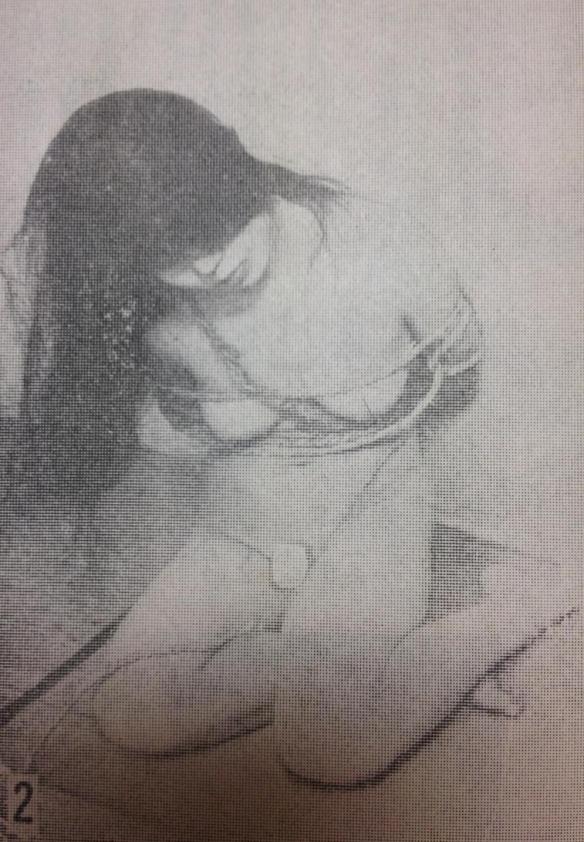 Picture 2
Picture 2
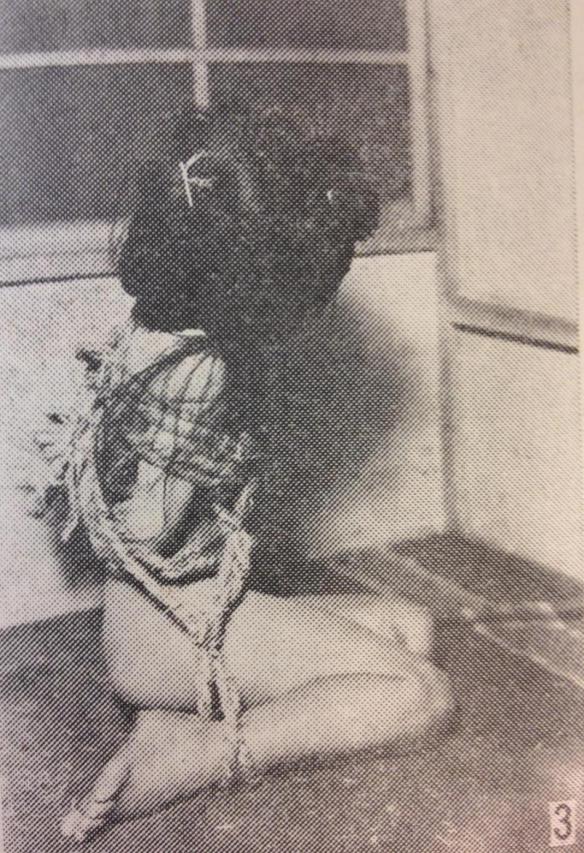 Picture 3: A disarrangement of the Japanese hair style
Picture 3: A disarrangement of the Japanese hair style
I received the photos (1) and (2) from Seiu-sensei one time when he treated me to drinks in Ikebukuro. Sensei usually drank at a place called Taisaku in Hondai sakana machi, but I think he had errands in the area that day. I was a simple restaurant, and sensei suddenly said: ”I’ll give you these”, and put the photos on the table. Looking at the pictures, I saw that it was pictures of a fully nude woman tied with her hands behind her back with aranawa [straw rope].
I heard myself spontaneously making a sound, surprised to see the photos: ‘Oh…!’. Now days, it is not uncommon with fully nude shibari, but at that point in time, they were very rare. I was shown these most stimulating things I’d ever seen and my head started spinning. That’s how thrilling it was.
‘S-sensei…!’
‘I’ll give them to you if you like them.’
‘Really? For sure? Thank you!’
I was touched. This was before Uramado was published, so pictures of a woman tied up with aranawa were practically non-existent; They were treasures. Frankly, the blood was rushing to my crotch.
Sensei also had his bad sides. He got me drunk and showed me, someone who likes these kinds of things, these photos. Seeing this, your hearts starts racing and your face grows red. My excitement was anticipated, and my crotch got hard, and seeing this, sensei grinned. I carefully took the three photos I received that night home to my apartment in Hatagaya. When I came home, I masturbated and it felt like my hips were melting.
Of the three photos I received, sensei liked the third best. As noticeable in his drawings, sensei liked the traditional Japanese hairstyle that had become disarranged. This scene probably spoke to him on a sexual level, seeing the cord tying the hair almost about to snap. Speaking of photos, photo (4) is treasured masterpiece.
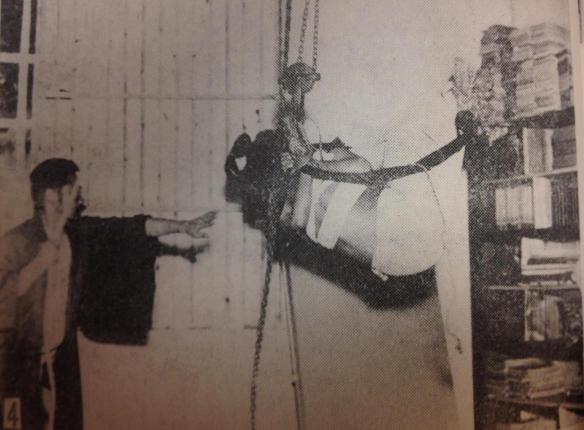 Picture 4: Is that your wife, so gruesomely suspended?
Picture 4: Is that your wife, so gruesomely suspended?
I received this photo along with the others. At the time, I was an editor for Uramado, and this was to be published in the magazine. It’s probably an unpublished treasure. I don’t know when it was taken, but looking at the photo, it looks like it was taken in sensei’s art studio. Sensei had done a suspension of his pregnant wife like in the image ”The Lonely House on Adachi Moor” and wrote about the hardships he had encountered in Kitan Club. Perhaps photo (4) is from that time?
They must have thought ‘how about this?’, tried to take a photo, setting the focus on the camera. However, it seems the rope was slowly slipping, so it didn’t go too well.
The person to the left seems to be sensei, but back then they didn’t have the flashlight cameras or panchromatic film we have today.
They had to retake many of the photos, so it is most likely one of those retakes. Nowadays, there are loads of automatic cameras, but that’s not how it was back then. This photo shows just how hard it was taking photos with those old cameras.
It goes without saying he couldn’t do it without the pregnant model and her do-or-die spirit as she is tied up and suspended, but I think about Seiu-sensei with respect when I think about the tenacity needed doing this.
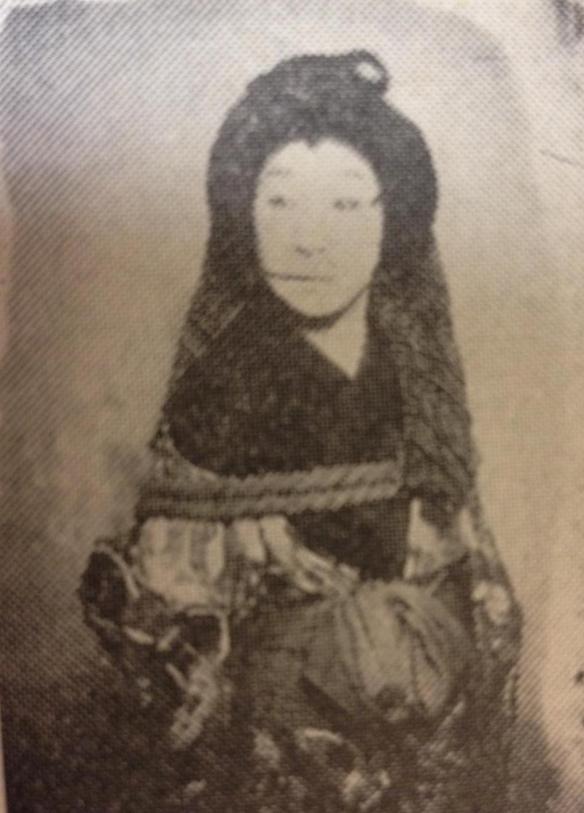 Picture 5: Tying up a kabuki oyama
Picture 5: Tying up a kabuki oyama
 Picture 6: Torment and the beauty of a traditional Japanese hairstyle
Picture 6: Torment and the beauty of a traditional Japanese hairstyle
The photo (5) is a very rare photo from a glass plate. It’s taken with a dry plate, and the person in it is probably a kabuki oyama [male actor in female kabuki role]. As sensei had mentioned in ”My Emotional Landscape When Drawing Women in Torment”, he entered the world of kabuki to research for scenes of tormented women. There is a story published in Kitan Club that is about precisely this, in his series of texts labelled ”sexual fluids” [1954].
The oyama in the picture was probably somebody important in the kabuki world, but I can no longer remember the name. The same applies to the woman in picture (6), and it’s such a shame that the names are forgotten. This was taken at a certain SM-enthusiast meeting where Seiu-sensei himself tied up a beauty. In pictures (7) and (8), you can see Seiu-sensei standing behind her. These are very rare photos.
Maybe, some of the readers will look at picture (7) and think: ‘Oh, but that’s me!”
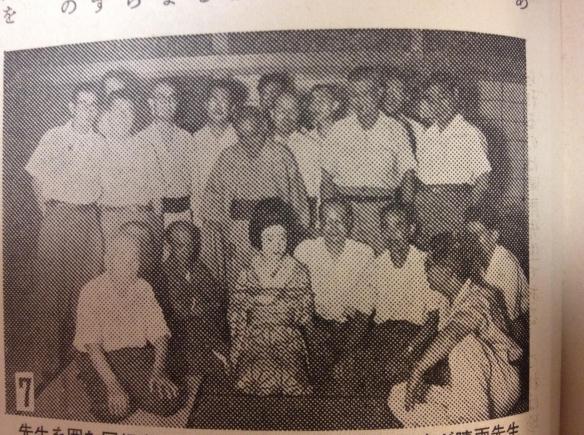 Picture 7: SM-enthusiasts surrounding the yukata-clothed Seiu-sensei
Picture 7: SM-enthusiasts surrounding the yukata-clothed Seiu-sensei
This event was held by the owner of Chikusui bookstore, Mr. Itoh Chikusui. Quite a few were present at the meeting. There were some people I know, and some have already passed away. Seiu-sensei, clothed in a yukata stands in the middle. The old man in the front row, wearing a white shirt with his hands on his knees is Mr. Itoh Chikusui.
I believe he has done much for other enthusiasts, also for me, and he passed away shortly before Seiu-sensei did. The two were good friends, and although they did argue from time to time, in essence they got along well.
Among the people behind them are authors, critics – a whole world of able persons.
It has slipped away from me whom the beautiful woman sitting in front of Seiu-sensei is, but I’ve heard she was quite exquisite. In picture (8), Seiu-sensei is forcefully making her sit down by holding her collar in that pose. That’s some nice care to give.
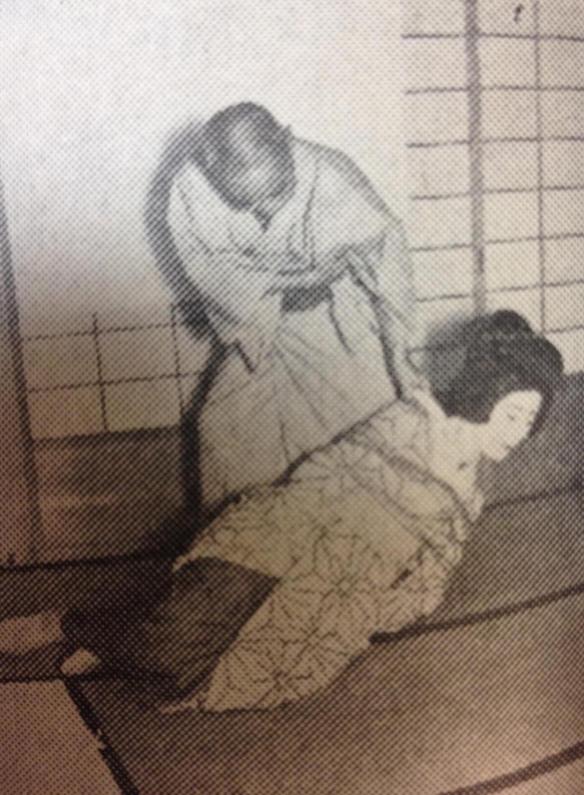 Picture 8: Seiu-sensei creating a pose
Picture 8: Seiu-sensei creating a pose
I’ve been to this kind of photo sessions with sensei several times, and he has a lot of fun tying women up. His eyes become squinty and he is like a fish in the water.
Picture (9) is a piece that he worked hard for, the ”Snow Torment” [yukizeme, 雪責]. Sensei has written a lot about this photo session in the snow. However, it isn’t made clear who the model is. Thinking back, I wish I had asked him about that, but nothing can be done now.
I have done shibari in the snow as well, and it is very difficult for both the model and the photographer. Your limbs feel like they are falling off, so you can’t really express the beauty of torment. With that in mind, sensei must’ve struggled during that photo session.
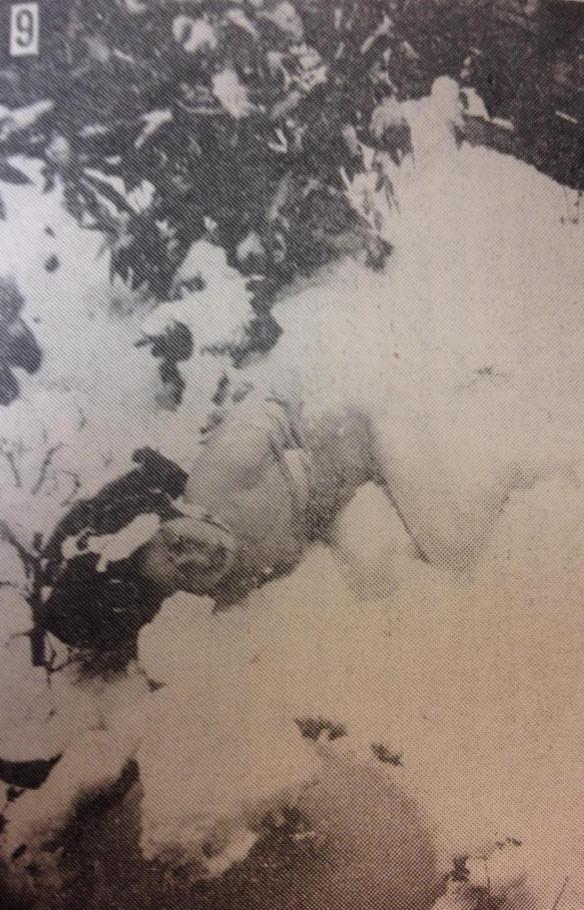 Picture 9: A scene of the famous Snow Torment, where the model fainted
Picture 9: A scene of the famous Snow Torment, where the model fainted
In pictures 10–15, aranawa is used to tie the models at the photo session. Picture 11 is the same oyama mentioned before, and as always, you can feel sensei’s infatuation with the disarranged traditional Japanese hairstyle.
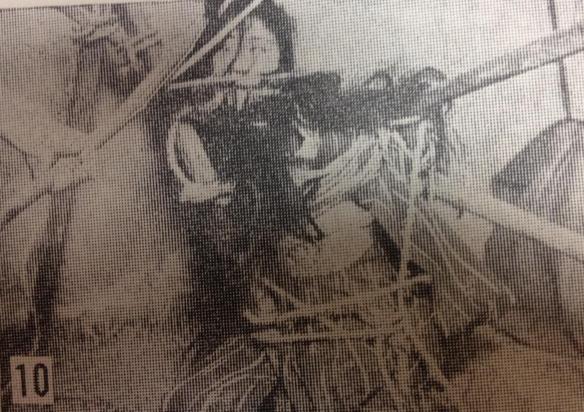 Picture 10: Black hair and rope wound together, becoming one
Picture 10: Black hair and rope wound together, becoming one
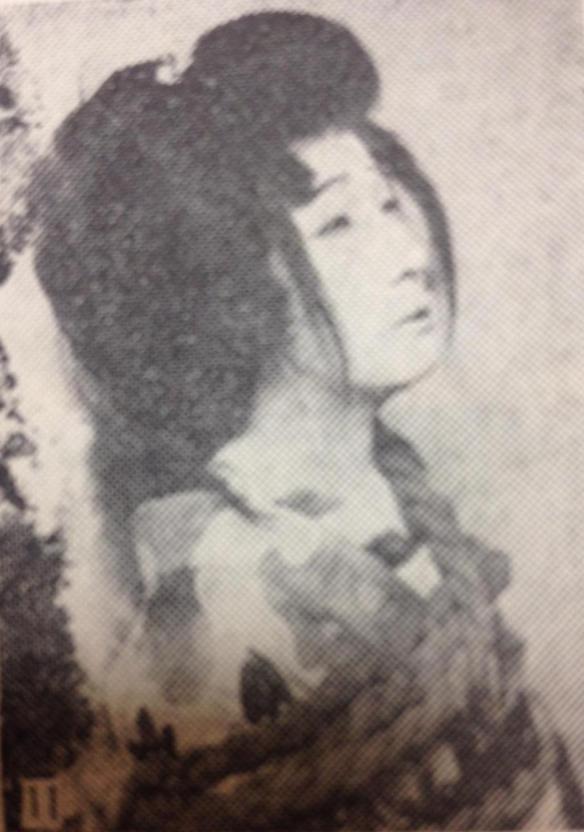 Picture 11: An elegance you don’t see nowadays
Picture 11: An elegance you don’t see nowadays
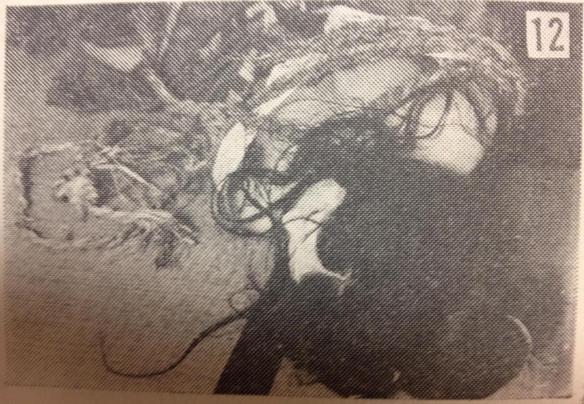 Picture 12: A torture scene filled with lyricism
Picture 12: A torture scene filled with lyricism
Looking very closely at pictures 13 and 14, I feel that they look like an oyama. What do you readers think?
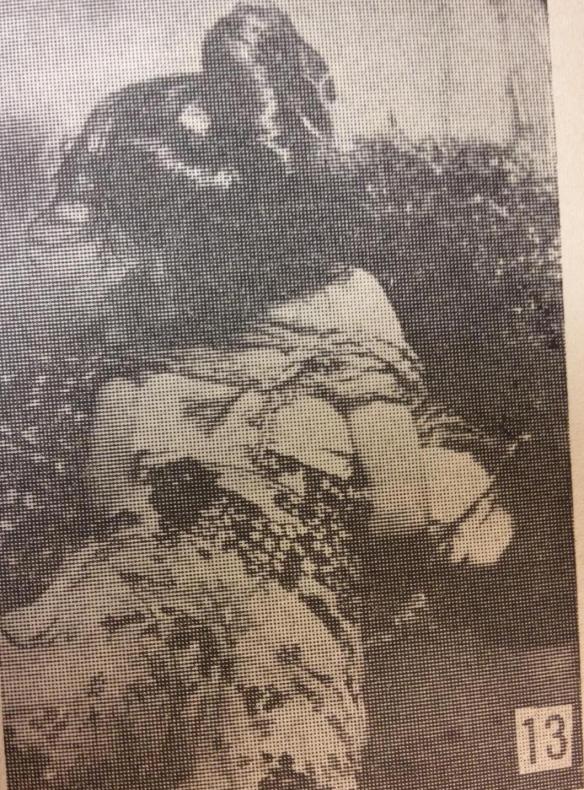
 Pictures 13 & 14: I would like to replicate these scenes
Pictures 13 & 14: I would like to replicate these scenes
 Picture 15: Another scene of torment and disarranged hair
Picture 15: Another scene of torment and disarranged hair
Returning to that night at the restaurant in Ikebukuro, I was treated to drinks and given the photos that would be published in Uramado.
”…Let’s go”, sensei said and asked for the bill and paid it.
Sensei’s wallet looked like a small cloth bag and at the opening there was a long string attached. He would wind up the string and take out the money when paying.
”Thank you for the treat”, I said politely.
”Well then…”
We went to the Ikebukuro bus-terminal and took a bus bound for Shinbashi.
I’ve been lost since coming to Tokyo, no sense of direction, so sensei told me ‘come with me’, and I just followed him.
Something memorable happened during the bus-ride. After sitting on the bus for 30 minutes, a woman with a traditional Japanese hairstyle boarded. She looked like a geisha. The smell of hair oil filled the bus.
”That’s nice, right? Really nice…”, sensei said to me and tried to peek down the back of her collar. He must have been fantasizing about tying up a geisha.
‘That is nice…yeah… Really nice’, he said, and tried peeking down her collar again. He kept saying ‘that’s nice’, over and over again, as if looking for conformation from me.
I signalled that I agreed with him, and looked at the expression on his face, happy as a baby. I accompanied him to Shinbashi, but I strangely can’t recall what we did. Sensei usually drank at a place called Taisaku in Hondai sakana machi. The mistress there had a beautiful way of walking, and was overall a sensual woman. It was obvious that she was sensei’s type. The mistress was a big fan of Seiu-sensei, and in a room where only regulars could sit, there was seme-e with rich colours, that everybody looked at while drinking. When sensei got drunk, his slim-wasted kimono slowly unravelled, and when that happened his fundoshi would show. At times, the fundoshi would loosen, and his penis would fall out. When this happened, the mistress of the bar carefully tucked it back in. Then it peeked through again, and got tucked back in. Sensei was like an unmanageable child; he must have enjoyed making the mistress do that.
Sensei didn’t marry until the age of 28, and until then he was a virgin. Even if he were like today’s youth, he must’ve led a very diligent and clever life. However, growing older he liked to be more of the happy-go-lucky type, telling lots of anecdotes.
He did many eccentric things, like turning over the paper lanterns of police that came arrest the drunkards, stopping trains, paying with railway tickets for the alcohol when he didn’t have enough money… etc. People saw him as an eccentric person.
Tying up a pregnant woman like in the famous work of Mr. Yoshitoshi Tsukioka and taking photos; tying up a fully nude woman out in the snow to sketch her and pushing it to the point of her fainting… Simply speaking, these are anecdotes that society would frown upon. However, to me, it says a lot about Seiu’s great ability to take action, and his passion in the pursuit of his truth.
There are no evil spirits if there is no ill will. Not to mention, not caring about the views of mainstream society and of rising above caring what reputation he might get. Walking his own path at full speed – born and raised in Edo.
I met sensei also at another meeting for SM-enthusiasts and had the privilege to sit by him. I had been to sessions like this before where he would tie up the female model, but this one left a strong impression on me.
Seme-e was a region of his interests; he had started as a genre painter, and he was among the best. From a young age, he had drawn clippings and billboards for plays. As an artist, he had even painted billboards for kabuki, rakugo, shingeki, and public corporations, so he knew many different people, and nobody would badmouth him. Even though he was considered a master painter, he had little to no arrogance to him. On the contrary, he found it troublesome for people to call him that. That was the kind of person he was.
When I came to Tokyo in 1954, I had no time for an idle life and started working for Amatoria-sha as an editor for Amatoria (Uramado was after this). It was around that time, that the writers hired by the company were invited to a temple, Ryousenji in Izu. The following is what happened on the bus-trip there. We called the trip ‘Amatoria festival’ and had it written on a red banner with white letters and put it at the back of the bus. Sensei sat right in the back seats and kept drinking happily, and as you know, the more you drink the more you need to pee. As we couldn’t stop the bus until arrival, sensei was a bit troubled. And I happened to witness, as he pretended as nothing was happening and urinated into his cup of beer. He put the cup to his mouth. When they filled his glass, he continued drinking and when nature called, he emptied his bladder in it. On top of it, the person next to him ended up drinking this urine and beer mixture as well. During this time, everybody was engaged in spirited discussion. There were jokes and puns coming one after the other. Sensei was smiling broadly with his round baby-like face, and his eyes sunk into his wrinkles. His eyes were kind and beautiful.
Sensei was without doubt happy at this period in time, and at times when he was really happy, he smiled so broadly he slobbered. After becoming an editor for Uramado, I came to meet sensei often. I would also join him for drinks, often at aforementioned Taisaku in Hondai sakana machi.
When Seiu-sensei passed away [January 1961], I proposed to Mr. Takahashi Tetsu that we hold a memorial for sensei Seiu, and now that he also has passed away [1971], I don’t know what will become of these memorials. It’s a bit lonely.
Next, I will talk to Mr. Dan Oniroku as well and perhaps attempt to organise a memorial for sensei. It was cold on the day of the funeral. Sensei didn’t like grandiose gestures, so the publishing company sent modest, but beautiful flowers with that in mind.
At the funeral, I remember seeing master 長老今輔 and master 金馬師匠 from the rakugo [storytelling] world. Also, among magazine related people were, in addition to the editor from Naigai Times, also Mr. Ueda Seishiro, as well as other publishers from different parts of Japan.
From Amatoria-sha there was me, the chief editor for Manhunt magazine [マンハント, published 1958–1964], as well as Mr. Nakata Masahisa. As for other editors and ones that are still working with SM-magazines right now, I can’t remember any. While Mr. Takahashi Tetsu and Mr. Higashi Kikitomo and other attendees were seeing sensei off, I endured the sadness and helped carry sensei’s coffin down the alley.
Ah, a great man has fallen, without much resistance in the world.
Itoh Seiu-sensei passed away in 28 January 1961, at the age of 81. Just a couple of days before a new issue of Uramado was sold in bookstores.
In that issue, there is a featured story by the newcomer SM-author Hanamaki Kyouta’s called “Literary Club Member Y – An Illustrated Story ”. This same Hanamaki Kyouta a pseudonym for Mr. Dan Oniroku – one of his first publications in a magazine. It’s funny that at the same time a great man falls, Mr. Dan Oniroku takes his first steps.
To close, I’ll say one more thing regarding sensei. Mr. Takahashi Tetsu wrote this about sensei’s multi-volume work The History of customs of old Edo: “I will forever be thankful and looking up to Naito Shizuka and Nozawa Seiza [pseudonyms Itoh used in his youth] and remember how they became, in the Taisho era [1912–1926], Seiu Itoh.”
Although sensei’s work stopped, there have been people wanting to know more about the person and artist Itoh Seiu – so how about a get-together? The 28th of January is the anniversary of the old man’s death. That is a time of the year when it’s quite cold outside, so I propose instead his birthday, the 3rd of March, during the peach festival. Let’s get together regardless of the weather, be it sunny or rain. Let’s indulge in his art, have a ghost festival and drink in his honour. If we do that, I’m sure he’ll be very happy about it. Well, please let me hear your opinions. Spring and lanterns are still far away.
If you have opinions about the Seiu memorial, please reach out to Mr. Minomura Kou. The late Mr. Takahashi Tetsu’s quotation was taken from the book『江戸と東京 風俗野史』(有光書房, 1971).
*************
Translated by Shiba, commissioned and edited by Bergborg / KinbakuBooks

